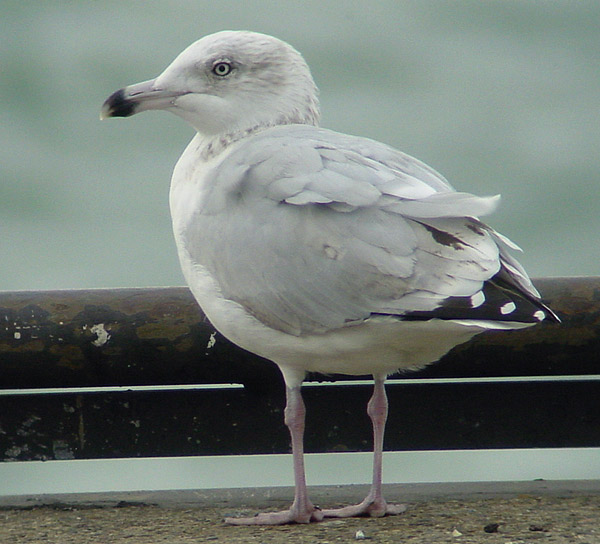 Herring
Gull - Zilvermeeuw (argentatus & argenteus): sub-ad September
Herring
Gull - Zilvermeeuw (argentatus & argenteus): sub-ad September
(last update: 22 september 2004)
Home
Links
to Gull Sites
Gull Taxa
Gull Topography
Grey & Colour Charts
Locations in NW Europe
Summaries of Articles
About ORG
@
(2 images) Herring Gull (argenteus)4cy, September 21 2004, Scheveningen, the Netherlands.
4cy argenteus with obvious dark tertial spots. Primary moult score: P7 fully grown.

From June (often mid-May in France, Belgium and the Netherlands) to October, a complete moult will bring birds in so-called "sub-adult winter" plumage. A new set of primaries will grow during the summer months and by October, the old primaries are all shed in argenteus in the Netherlands and northern France. In most adults (!), the new primary P6 is just visible beneath the tertials and shows a clear sub-terminal band. By late-September, P6 and P7 are fully-grown as well. At the same time, almost all wing-coverts have been renewed. In summer, the head is still largely white, but by September, most birds develop extensive 'winter streaking', in sub-adults strongly mottled brown contrasting with the white breast as in an executioner's hood. The tertials show obvious white tips. The iris is white-yellow with extensive speckling. The bill has a red gonydeal spot confined to the lower mandible. The orbital ring is yellow-orange in most argenteus, but often dark in autumn.
|
September primary moult scores in sub-adult & adult Herring Gulls at Scheveningen. |
||||||||||
| . | 30.08.2000 | 01.09.2000 | 01.09.2000 | 05.09.2001 | 07.09.2000 | 18.09.2000 | 21.09.2000 | 21.09.2001 | 26.09.2001 | 30.09.2000 |
| 0 | . | . | . | . | . | . | . | . | . | . |
| 1 | . | 1 | . | 3 | 3 | . | . | . | . | . |
| 2 | 4 | 4 | 9 | 19 | 15 | . | . | . | . | . |
| 3 | 7 | 5 | 41 | 32 | 30 | . | . | . | . | . |
| 4 | . | . | 10 | 4 | . | 7 | . | . | . | . |
| 5 | . | . | 1 | . | . | 35 | 42 | 7 | 24 | 2 |
| 6 | . | . | . | . | . | 36 | 60 | 24 | 62 | 38 |
| 7 | . | . | . | . | . | 11 | 20 | 9 | 12 | 43 |
| 8 | . | . | . | . | . | 2 | 3 | . | . | 1 |
| n: | 11 | 10 | 61 | 58 | 48 | 91 | 125 | 40 | 98 | 84 |
| average | 2,64 | 2,40 | 3,05 | 2,64 | 2,56 | 5,63 | 5,87 | 6,05 | 5,88 | 6,51 |
| Variance (s2) | 0,25 | 0,49 | 0,38 | 0,48 | 0,38 | 0,77 | 0,58 | 0,41 | 0,36 | 0,33 |
| SD (s) | 0,50 | 0,70 | 0,62 | 0,69 | 0,62 | 0,88 | 0,76 | 0,64 | 0,60 | 0,57 |
| SE (sx) | 0,15 | 0,22 | 0,08 | 0,09 | 0,09 | 0,09 | 0,07 | 0,10 | 0,06 | 0,06 |
| Notes: 30.08 - 07.09: number of remaining old primaries sub-ad and adults (thus 1 = P10 still old). 18.09 - 30.09: number of new primaries in adults (hence 6 = P6 full grown). *) By September, local argenteus get company from argentatus from Norway, which have on average lower moult scores and from argentatus from the Baltic region, which have equal moult scores probably. |
||||||||||
